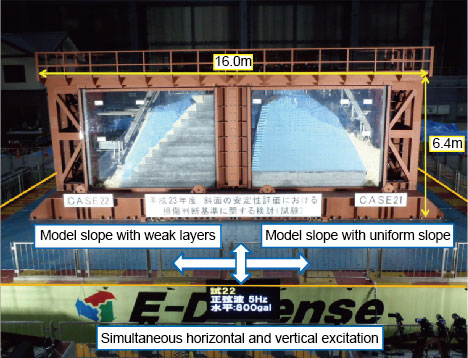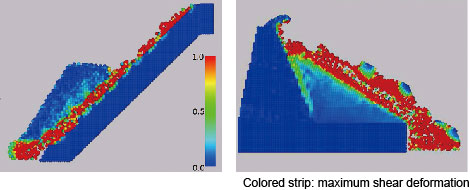3.Evaluation of rock slope stability using large scale shaking table experiments
- Experiments using simulation rock slopes were carried out on a large scale shaking table. Simultaneous horizontal and vertical excitation provided insight into slope dynamic behavior and failure mechanisms.
- This method can be applied to evaluate the stability of natural slopes along railway lines in case of seismic activity.
Following a commission from the Japan Nuclear Energy Safety Organisation to improve the method used for evaluating the stability of the many rocky slopes also existing along railway lines, RTRI conducted a number of analytical and experimental investigations to gain an insight into their dynamic behavior and failure mechanisms. Consequently two model earth replicas of full size slopes were subjected to excitation experiments on the E-Defense 3D full scale earthquake testing facility (large shaking table) at the National Research Institute for Earth Sciences and Disaster Prevention (Fig.1).
Applying vertical and horizontal phase altering sinusoidal waves and observed waves measured from the Niigataken Chuetsu-oki Earthquake, it demonstrated and confirmed that there was a transformation and increase in response acceleration in the tangential direction of the slope surface. For analysis, the earth slope was divided into discretized elements, and its deformation was found through a discretized particle method with mesh based particle and deformation computation, referring to Material Point Method. Results revealed that Material Point Method enabled tracking of major slope deformation and slope failure mechanisms, which had been difficult to obtain under previous methods (Fig.2).
The above results confirm this approach as a means to obtain finely detailed stability assessments in the case of seismic activity, for the many natural slopes along railway lines.

Fig.1 Experiment with large scale shaking table and model slopes
Fig.2 Maximum shear deformation contour according to Material Point Method